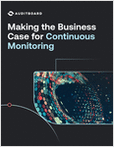 | While annual audits and random sampling can help protect the enterprise, it places a heavy burden on those involved to detect and examine suspicious activity. Rather than relying on these point-in-time checks, continuous monitoring uses automation to gather and test data in real time — enabling management to discover exceptions early and ensure they are in compliance with company and security policies, procedures, and processes. Additional benefits of employing continuous monitoring include:
For example, having the ability to analyze every customer’s refund and return helps detect fraud and abuse, including collusion between employees and customers. Continuous monitoring can allow your company to focus on the timing, magnitude, and employees involved to uncover policy or procedure violations. While continuous monitoring provides executives greater visibility and transparency, there may be resistance to its adoption stemming from a misunderstanding of what continuous monitoring is. Use this downloadable article to make the business case for it by understanding five key benefits and how to overcome common roadblocks on the path to implementation. Request Free! |
